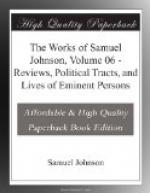“As to his second assertion, that it was regularly and judicially given in, and, therefore, ought to have been canvassed, by Mary during the conferences; we have already seen, that this, likewise, is not fact: the conferences broke up in February, 1569: Nicholas Hubert was not hanged till August thereafter, and his dying confession, as Mr. Hume calls it, is only dated the 10th of that month. How, then, can this gentleman gravely tell us, that this confession was judicially given in, and ought to have been, at that very time, canvassed by queen Mary and her commissioners? Such positive assertions, apparently contrary to fact, are unworthy the character of an historian, and may, very justly, render his decision, with respect to evidences of a higher nature, very dubious. In answer, then, to Mr. Hume: As the queen’s accusers did not choose to produce this material witness, Paris, whom they had alive and in their hands, nor any declaration or confession, from him, at the critical and proper time for having it canvassed by the queen, I apprehend our author’s conclusion may fairly be used against himself; that it is in vain, at present, to support the improbabilities and absurdities in a confession, taken in a clandestine way, nobody knows how, and produced, after Paris’s death, by nobody knows whom, and, from every appearance, destitute of every formality, requisite and common to such sort of evidence: for these reasons, I am under no sort of hesitation to give sentence against Nicholas Hubert’s confession, as a gross imposture and forgery.”
The state of the evidence relating to the letters is this:
Morton affirms, that they were taken in the hands of Dalgleish. Hie examination of Dalgleish is still extant, and he appears never to have been once interrogated concerning the letters.
Morton and Murray affirm, that they were written by the queen’s hand; they were carefully concealed from Mary and her commissioners, and were never collated by one man, who could desire to disprove them.
Several of the incidents mentioned in the letters are confirmed by the oath of Crawfurd, one of Lennox’s defendants, and some of the incidents are so minute, as that they could scarcely be thought on by a forger. Crawfurd’s testimony is not without suspicion. Whoever practises forgery, endeavours to make truth the vehicle of falsehood.
Of a prince’s life very minute incidents are known; and if any are too slight to be remarked, they may be safely feigned, for they are, likewise, too slight to be contradicted. But there are still more reasons for doubting the genuineness of these letters. They had no date of time or place, no seal, no direction, no superscription.
The only evidences that could prove their authenticity were Dalgleish and Paris; of which Dalgleish, at his trial, was never questioned about them; Paris was never publickly tried, though he was kept alive through the time of the conference.




